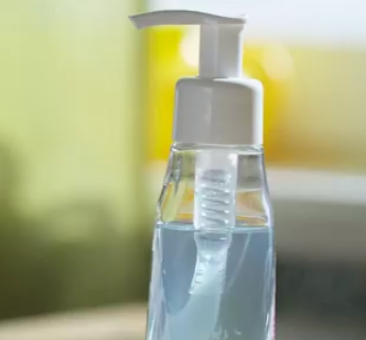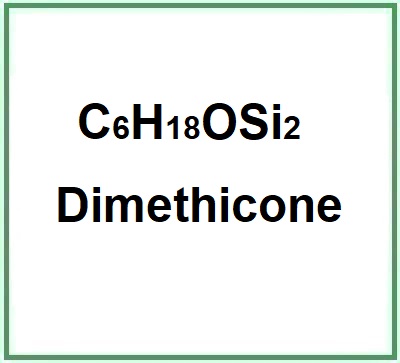Dimethicone ((polydimethylsiloxane) is a chemical compound, a high molecular weight polymer derived from silicone, a chemically inert mixture of linear methylated siloxane polymers. The term 'dimeth' denotes two methyl groups bonded to the silicone molecule that provide the formation of dimethicone. It possesses a pronounced viscoelasticity characteristic and is hydrophobic, thus adding shine and slipperiness when applied to hair or skin. It forms a kind of barrier that prevents exogenous substances from entering the stratum corneum and at the same time prevents water loss. It is also UV-resistant, non-greasy and cost-effective. At low concentrations it is considered by the US FDA (Food and Drug Administration) to be a skin protector with a good degree of safety.
It is therefore considered safe when formulated to be non-irritating in cosmetic products as, given its high molecular weight, it is poorly absorbed by the skin or scalp.
It comes in the form of a colorless transparent liquid. At high temperatures it behaves as a viscous liquid, while at low temperatures it assumes a rubbery behavior. It is resistant to water and UV rays.
Industrially it is produced in different formats that are distinguished by a number indicating the nominal kinematic viscosity placed after the name. The number appearing after the abbreviation PEG represents the molecular weight and the higher this number is, the less it penetrates the skin.
Dimeticone BP (Poly(dimethylsiloxane) CAS 9006-75-9
Dimethicone USP (-(Trimethylsilyl)- -methylpoly[oxy(dimethylsilylene) CAS 9006-65-9 [–(CH3)2SiO–]n

What it is used for and where
It acts as an emulsifier and is used in the cosmetic industry in liquid soaps, shampoos and more. It is a non-neurotoxic topical agent. It is often used in hair products both for its hydrophobic feature that makes the hair smooth and for its high molecular weight that, on the skin, prevents the penetration of exogenous substances, protecting the skin. At concentrations between 1% and 30% it is considered safe. It is mainly an emulsifier and in tablets it has the function of antifoaming.
Cosmetics
Antifoaming agent. The constituent factors for foam stabilisation are the concentration of nanoparticles and hydrophobicity. Foam, even when used in separation operations such as fractionation or flotation, can cause a decrease in density and a deterioration in quality in cosmetic products. The defoaming agent (non-polar oil, silicone oils, hydrophobic solid particles or mixtures of both) is strongly influenced by viscosity and, to an almost directly proportional extent, concentration. However, defoamers can carry an irreversible source of contamination.
Skin conditioning agent. An ingredient that is the mainstay of topical skin treatment by restoring, increasing or improving skin tolerance to external factors, including melanocyte tolerance. The most important function of the conditioning agent is to prevent skin dehydration, but the subject is rather complex and involves emollients and humectants.
Skin conditioning agent - Emollient. Emollients have the characteristic of enhancing the skin barrier through a source of exogenous lipids that adhere to the skin, improving barrier properties by filling gaps in intercorneocyte clusters to improve hydration while protecting against inflammation. In practice, they have the ability to create a barrier that prevents transepidermal water loss. Emollients are described as degreasing or refreshing additives that improve the lipid content of the upper layers of the skin by preventing degreasing and drying of the skin. The problem with emollients is that many have a strong lipophilic character and are identified as occlusive ingredients; they are oily and fatty materials that remain on the skin surface and reduce transepidermal water loss. In cosmetics, emollients and moisturisers are often considered synonymous with humectants and occlusives.
Skin protectant. It creates a protective barrier on the skin to defend it from harmful substances, irritants, allergens, pathogens that can cause various inflammatory conditions. These products can also improve the natural skin barrier and in most cases more than one is needed to achieve an effective result.
Medical
Dimethicone is considered to be a safe and highly effective treatment for lice in pediatrics (1) definitely better than permethrin. Effective in the treatment of Actinic Keratoses on the face (2). Effective in the management of reflux oesophagitis (3).
Pharmaceuticals
Dimethicone is used as a lubricant in various pharmaceutical formulations, including solid oral dosage forms such as tablets and capsules. It helps improve the flow properties of powders during the manufacturing process and aids in the easy swallowing of tablets or capsules.
Safety
Safe as used in cosmetic formulations (4).
For more information:
Dimethicone studies
Typical characteristics of commercial product Octamethyltrisiloxane (Dimethicone)
| Appearance | Transparent colorless liquid |
| Viscosity | 1.0 cSt(25 °C) |
| Purity | 99% |
| Melting point | -82 °C |
| Boiling point | 153 °C(lit.) |
| Vapor density | >1 (vs air) |
| Flash point | 37.2°C |
| Specific Gravity | 0.82 |
| D4 content % | <0.1 |
| Shelif life | 24 months |
- Molecular Formula C8H24O2Si3
- Linear Formula [(CH3)3SiO]2Si(CH3)2
- Molecular Weight 236.533 g/mol
- CAS 63148-62-9 9006-65-9 / 9016-00-6
- UNII 9G1ZW13R0G
- EC Number
- DSSTox Substance ID
- MDL number MFCD00008264
- PubChem Substance ID 24870584
- InChl 1S/C8H24O2Si3/c1-11(2,3)9-13(7,8)10-12(4,5)6/h1-8H3
- InChI Key CXQXSVUQTKDNFP-UHFFFAOYSA-N
- SMILES C[Si](C)(C)O[Si](C)(C)O[Si](C)(C)C
- IUPAC dimethyl-bis(trimethylsilyloxy)silane
- ChEBI 9147
- NACRES NA.23
Synonyms :
- Octamethyltrisiloxane
- Octamethyl-Trisiloxane
- Polydimethylsiloxane
- Dimethicone
- Polidimetilsilossano
- Poly(oxy(dimethylsilylene)), alpha-(trimethylsilyl)-omega-methyl-
- Trisiloxane, 1,1,1,3,3,5,5,5-octamethyl-
- alpha-(Trimethylsilyl)-omega-methylpoly(oxy(dimethylsilylene))
- Dimethyl polysiloxane, dimethyl-terminated
- Dimethylbis(trimethylsilyloxy)silane
- dimethyl-bis(trimethylsilyloxy)silane
- Dimethyl polysiloxane, bis(trimethylsilyl)-terminated
References_________________________________________________________________________
(1) Ihde ES, Boscamp JR, Loh JM, Rosen L. Safety and efficacy of a 100% dimethicone pediculocide in school-age children. BMC Pediatr. 2015 Jun 20;15:70. doi: 10.1186/s12887-015-0381-0. Erratum in: BMC Pediatr. 2016;16:12.
(2) Jim On SC, Hashim PW, Nia JK, Lebwohl MG. Assessment of Efficacy and Irritation of Ingenol Mebutate Gel 0.015% Used With or Without Dimethicone Lotion for Treatment of Actinic Keratosis on the Face. J Drugs Dermatol. 2017 May 1;16(5):432-436.
(3) Smart HL, Atkinson M. Comparison of a dimethicone/antacid (Asilone gel) with an alginate/antacid (Gaviscon liquid) in the management of reflux oesophagitis. J R Soc Med. 1990 Sep;83(9):554-6.
(4) Becker LC, Bergfeld WF, Belsito DV, Hill RA, Klaassen CD, Liebler DC, Marks JG Jr, Shank RC, Slaga TJ, Snyder PW, Andersen FA. Safety Assessment of Dimethicone Crosspolymers as Used in Cosmetics. Int J Toxicol. 2014 May;33(2 suppl):65S-115S. doi: 10.1177/1091581814524963.
![]() Dimethicone
Dimethicone 






